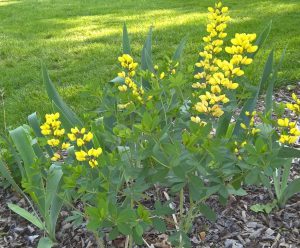Baptisia Australis- Yellow Indigo?
Views: 3839

Last spring, Wonderful Husband, the Spoiled Mutt and I made our annual pilgrimage down to Hastings’ Plants. Hastings is located just about as far southwest as one can travel in Indiana and not be in Kentucky – near the confluence of the Wabash and Ohio Rivers. It’s on a fifth generation farm and is a Mecca for gardeners all around the area. Unless, of course, the river is up and then you can’t get there from anywhere.
Nancy, the owner, is a very pleasant woman with a suntanned face, blue eyes, curly auburn hair and I don’t think I’ve ever seen her not smiling. She grows her own plants, which are good quality; always has a selection of native plants and cultivars and her prices are very reasonable. Besides, it’s just downright fun to make a road trip down to Nancy’s.
As soon as we arrived and saw all those lovely plants, we forgot all about our resolution to be sensible. Wonderful Husband saw a big, striking plant with yellow blooms in one of Nancy’s display beds. Not being shy, he asked her about it.
“It’s a yellow baptisia,” she said.
I don’t really need to tell you we bought one yellow baptisia (and two blue ones). Baptisia (Baptisia australis) is also known as false indigo, blue false indigo or wild blue indigo, so the brilliant yellow flowers are certainly noticeable. We bought a cultivar called “Yellow Meringue”.
An herbaceous perennial, Baptisia is native to eastern North America; hardy from Zones 3 to 9; will grow in full sun to part shade; has moderate water needs and (Hurray!) tolerates clay soils. Since full sun is really difficult to find in my gardens, Yellow Meringue is probably planted in a shadier spot than it would like, but it came through the winter and bloomed for the first time this spring. Those yellow blossoms glowed like jewels against the shaded background. It’s a member of the pea family (Fabaceae) and its blossoms (whether blue or yellow) certainly look like a pea blossom.
There’s no real need to deadhead the spent flowers, let them set seed. Baptisia is one of those plants which provide multiple benefits: first, the lovely flowers; second, it attracts butterflies, and third, it forms these really dark seed pods which has use in flower arrangements. It will spread by rhizomes and Lemon Meringue may grow up to three feet tall by three feet wide. Although, in the shady spot where we planted it, I doubt it will get that large.
This is another plant which is toxic – so just because it is in the pea family and looks like a pea, don’t eat it or the seeds – just enjoy the blue (or yellow) blooms, the butterflies and Stay Green, good friends!
Meet Dona Bergman
Dona Bergman is a founding member, Southwest Indiana Chapter of the Indiana Native Plant & Wildlife Society, and an Advanced Master Gardener.







